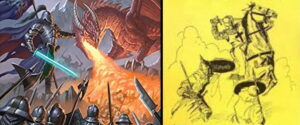A commenter over at The Joy of Wargaming asked which ruleset is better, Chainmail or Dragon Rampant. There is no easy answer to that question, but there is a great blog post of an answer.

The two titles are both fantasy mass-battle games, but they do very different things and serve very different purposes. They are both great games, and I would put them at the same level of complexity overall. They just have complex operations at different points in the game.
Both rulesets allow for big, sweeping battles that course back and forth across the table. They both feature late Dark Age to late Medieval armies. They both work well with and without the fantastic elements. You can get in a decent sized game in about an hour or two with both, and a massive battle over the course of a full afternoon. They both run smooth, if you can handle basic multiplication. And they both feature very strong combat and morale systems that integrate perfectly into the rest of the system.
Where they differ is purpose and use. For a quick throw-down, you’ll want to go with Dragon Rampant. It plays fast. It sets up quick. It features easily grasped victory conditions. And it lets you use small handfuls of figures for each unit. It’s easy to look at the table and understand exactly what unit is what, and where it is going, and what is happening. The game lends itself to narratives, but any campaign system will be tied very tightly to the tabletop rules of Dragon Rampant. If you sit down to draft a campaign that goes any deeper than mere narrative links, you’ll need to reference the tabletop rules and finagle a way to translate hard numbers on a map into figures on the table.
And that’s where the strength of Chainmail comes to the fore. The Chainmail system is built for translation from hard and fast numbers. As I demonstrate in my “Campaigning Alone: Chainmail” series, you don’t even need to think about the tabletop game of Chainmail at all when you’re happily shoving armies around a paper map. It’s not until those two armies come together to fight that you need to consider how the translation works. You just need to know how many of which types of troops are present, pick a ratio of figures to men, and you’re off to the races. You’ll get a fun experience on the table – even with grossly unbalanced forces or an unbalanced tactical situation. Chainmail excels at allowing for the unexpected, and at allowing you to squeeze your own odd wrinkles into the game. Want to use AD&D spellcasters in Chainmail? No problem!
Which makes sense. Chainmail was originally written as a way to take any historical battle account and get it onto the table. The idea of strip-mining history for gaming inspiration is built into her DNA. It doesn’t matter whether the history in question is our own real world or your own fairy-tale land, the game can handle it.
Frankly, I don’t know that Chainmail is interesting enough to be played absent a campaign system. Once you’ve played a half-dozen games, you’ve seen what it can do and start looking for something else. In the 1970s, they had to add giants and dragons and wizards to make it interesting. And even with that, they had to add in heroes and long-running arcs as those heroes established armies of their own. It’s a system that thrives on the long form campaign, and it suffers without one.
On the other hand, after a half-dozen games of Dragon Rampant, you’ll still have new tricks to try, new armies lists to build and use, and new victory conditions to achieve. The wonky activation system even adds re-playability to individual scenarios. Sure, you lost this one because that one unit couldn’t get off the starter’s block – let’s set them up and see what happens if they do!
They are both great systems, but they do different things. And I love them both for what they do.

